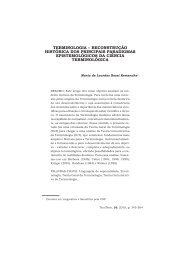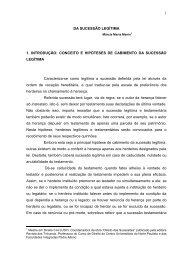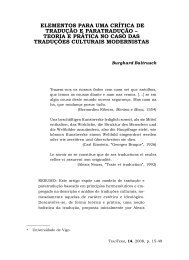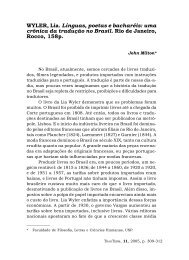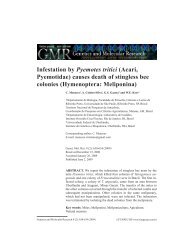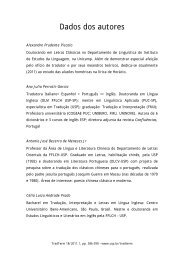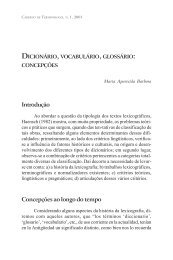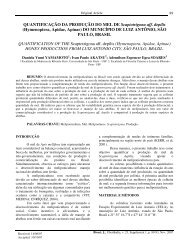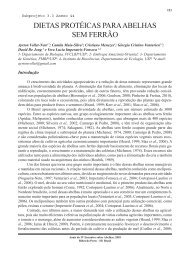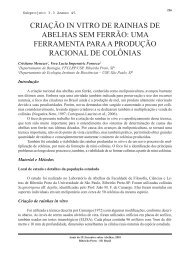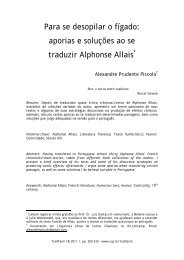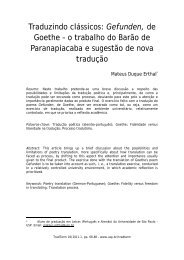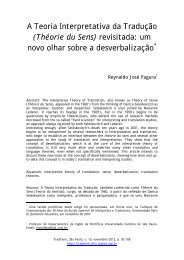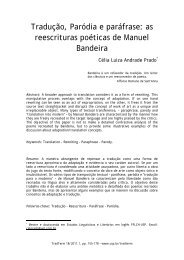Bees as pollinators in Brazil - USP
Bees as pollinators in Brazil - USP
Bees as pollinators in Brazil - USP
Create successful ePaper yourself
Turn your PDF publications into a flip-book with our unique Google optimized e-Paper software.
76<br />
grandiflorum), the poll<strong>in</strong>ation requirements<br />
are be<strong>in</strong>g studied (see table 1).<br />
Coevolution between local flora and st<strong>in</strong>gless<br />
bees should occur <strong>in</strong> high diverse habitats.<br />
Despite of their generalist use of floral<br />
resources, st<strong>in</strong>gless bees show floral preferences<br />
(Ramalho, et al., 1990; Biesmeijer, et al.,<br />
2005; Biesmeijer & Slaa, 2006). It is necessary<br />
to improve this knowledge <strong>in</strong> order to determ<strong>in</strong>e<br />
preferences and the ma<strong>in</strong> plants <strong>in</strong>dicated<br />
<strong>as</strong> food source for their successful<br />
breed<strong>in</strong>g, <strong>as</strong> well <strong>as</strong> for us<strong>in</strong>g <strong>in</strong> habitat<br />
restoration programs.<br />
A huge problem for <strong>Brazil</strong>ian st<strong>in</strong>gless<br />
bees breeders and for capacity build<strong>in</strong>g activities<br />
is that relevant literature is <strong>in</strong> English or not<br />
e<strong>as</strong>ily available; most bee species have not<br />
been studied yet. A recommendation is to<br />
make available, <strong>in</strong> Portuguese, a synthesis of<br />
the present knowledge, written for different<br />
stakeholders, and to provide b<strong>as</strong>ic knowledge<br />
needed for rear them. The WebBee (Saraiva, et<br />
al., 2004) w<strong>as</strong> constructed <strong>in</strong> order to be our<br />
<strong>in</strong>foway <strong>in</strong> this t<strong>as</strong>k.<br />
Consider<strong>in</strong>g the high biodiversity of st<strong>in</strong>gless<br />
bees, and the new meliponiculture regulation<br />
for research and for beekeep<strong>in</strong>g (CONA-<br />
MA_346, 2004), it is necessary to improve the<br />
development of breed<strong>in</strong>g techniques, <strong>in</strong> order<br />
to provide bees for research and for meliponiculture.<br />
Nests can be obta<strong>in</strong>ed by us<strong>in</strong>g trap<br />
nests <strong>in</strong> nature; a nest census and a bait-trap<br />
survey <strong>in</strong> natural and agricultural are<strong>as</strong> for st<strong>in</strong>gless<br />
bees is also a priority for <strong>in</strong>vestigation. A<br />
recent research developed <strong>in</strong> Sarawak, Asia,<br />
showed the effects of human disturbance on a<br />
st<strong>in</strong>gless bee community <strong>in</strong> a tropical ra<strong>in</strong>forest,<br />
<strong>as</strong> a result of changes <strong>in</strong> resources availability<br />
(Eltz, et al., 2002 and Eltz, et al., 2003;<br />
Samejima, et al., 2004). Such changes <strong>in</strong> the<br />
bee community may affect the reproductive<br />
success of plants and ultimately forest composition.<br />
Nests sites are considered <strong>as</strong> essential<br />
resources, and have some requirements, <strong>as</strong><br />
specialization <strong>in</strong> use of logs of some plant<br />
species or diameters at bre<strong>as</strong>t height bigger<br />
than 50cm. This h<strong>as</strong> implications for reforestation<br />
programs <strong>as</strong> well for the susta<strong>in</strong>able use of<br />
forest and the conservation of st<strong>in</strong>gless bees,<br />
important native <strong>poll<strong>in</strong>ators</strong> (Venturieri, 2004).<br />
The use of st<strong>in</strong>gless bees for poll<strong>in</strong>ation<br />
purposes should consider the settlement of<br />
corridors between patches of native vegetation<br />
for keep<strong>in</strong>g native populations of <strong>poll<strong>in</strong>ators</strong><br />
<strong>as</strong> well <strong>as</strong> trees for nest<strong>in</strong>g and flowers<br />
for food (nectar and pollen). As agriculture<br />
is <strong>in</strong>cre<strong>as</strong><strong>in</strong>g <strong>in</strong> <strong>Brazil</strong>, the land management<br />
of surround<strong>in</strong>g agricultural are<strong>as</strong> is also<br />
very important. F<strong>in</strong>ally, st<strong>in</strong>gless bees could<br />
be excellent <strong>poll<strong>in</strong>ators</strong> to be used by small<br />
farmers (family growers) because they do not<br />
st<strong>in</strong>g, are e<strong>as</strong>y to manage, and are appropriate<br />
to small lands and cheap to rear<strong>in</strong>g.<br />
Besides that, some small farmers have the<br />
traditional knowledge to rear<strong>in</strong>g them, us<strong>in</strong>g<br />
their honey <strong>as</strong> medic<strong>in</strong>e. They need to learn<br />
how to manage them for poll<strong>in</strong>ation and<br />
conservation purposes.<br />
State of art<br />
St<strong>in</strong>gless bees <strong>as</strong> greenhouses<br />
<strong>poll<strong>in</strong>ators</strong><br />
In 1988, Luci Rolandi Bego, from São Paulo<br />
University, went to Japan with a grant of<br />
<strong>Brazil</strong>ian Academy of Sciences to work with Y.<br />
Maeta on the use of st<strong>in</strong>gless bees <strong>as</strong> <strong>poll<strong>in</strong>ators</strong><br />
<strong>in</strong> strawberry greenhouses. She carried<br />
with her a colony of Nannotrigona testaceicornis,<br />
a colony of Plebeia droryana and one<br />
of Tetragonisca angustula, <strong>in</strong> rational hives,<br />
chosen by chance among the other species<br />
available at São Paulo University Bee<br />
Laboratory, where they were know to be very<br />
strong. Nannotrigona testaceicornis w<strong>as</strong> test-



